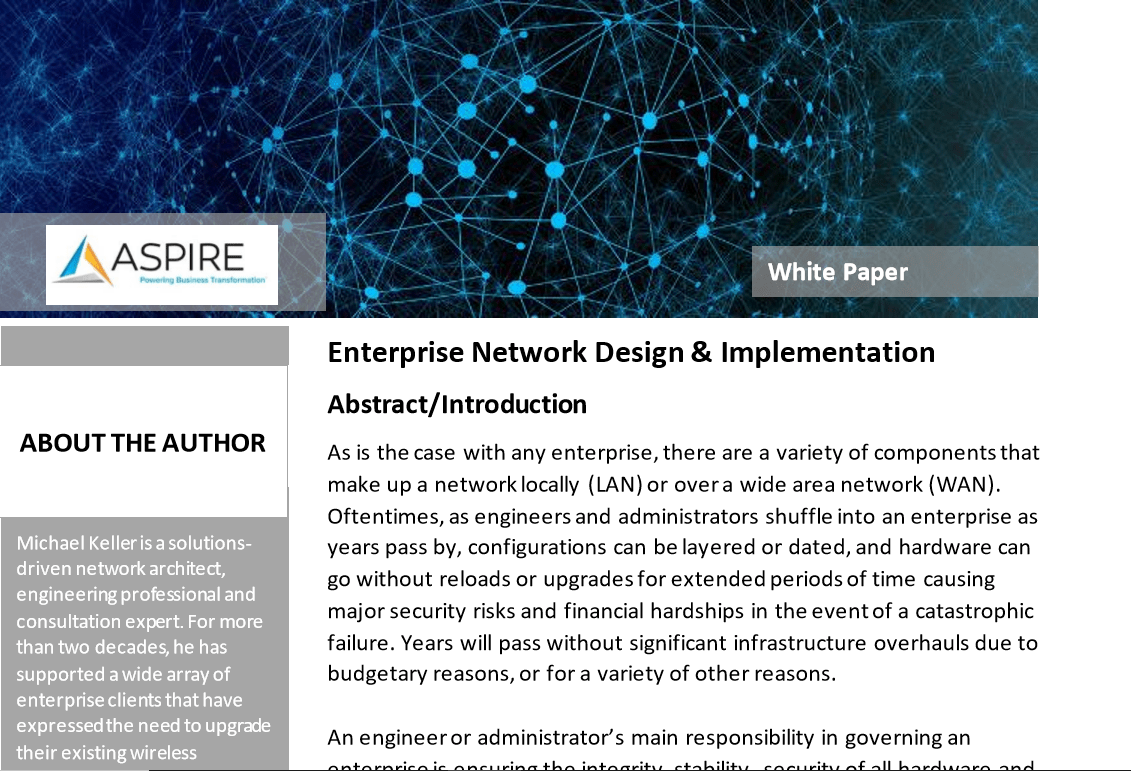An Engineer’s Guide to Enterprise Network Assessment and Design
By Michael Keller, Senior Consulting Engineering, Aspire Technology Partners
Introduction
As is the case with any enterprise, a variety of components make up a network locally (LAN) or over a wide area network (WAN). Oftentimes, as years pass by, and engineers and administrators shuffle in and out of an enterprise, configurations can be layered or dated, and hardware can go without reloads or upgrades for extended periods of time, causing major security risks and financial hardships in the event of a catastrophic failure. Enterprises often let too much time pass without conducting a network assessment, design, or redesign, due to budgetary reasons, or for a variety of other reasons.
An engineer’s, or an administrator’s main responsibility in governing an enterprise is ensuring the integrity, stability, and security of all hardware and systems. They must ensure the fluid continuity of operations while preemptively mitigating failures through redundancy and active/passive maintenance methods. In doing so, it’s critical to evaluate the overall health of a network. This is where a holistic, thorough network assessment approach comes into play. With this type of network assessment, everything from the cabling infrastructure in a distant, forgotten closet to the primary data center and perimeter data flow is reviewed and remediation techniques are put in place to pave a way forward towards optimizing the entire enterprise.
The key to any robust network assessment and or redesign is identifying the customer’s pain points, assessing areas of risk, and providing a fully redundant, scalable solution that includes remediation techniques and industry best practices that fit the customer’s vision of their own enterprise for the future with the help of a consultant.
Problem Statement: Enterprise Network Design and Assessment is sometimes overly complex
Putting out fires all day can be a trying task for any administrator or engineer, and time is precious. Oftentimes, an assessment is needed when active concerns exist within the enterprise. The concerns range from simple port configuration difficulties and network access concerns to intricate design and/or routing functionality.
Putting this into perspective is part of the assessor’s responsibility. It is imperative to understand how a network should function optimally without creating an overly complex solution that only adds headaches to an already overworked administrator or team of engineers.
Background: Enterprises Need Stability and Resilience Built into the Network
For years, the Cisco Hierarchical Network Design (CHND) has provided stability and resiliency for customers looking to optimize the architectural foundation of their enterprise. Comprising of multiple layers of functionality, the CHND provides a robust, redundant solution where symmetry exists from the access layer all the way to the provider, wherever possible.
Below is an example of the classic three-tier hierarchical design, comprised of three layers: the access, distribution, and core:

Please note that, while the three-tier design has been an industry standard for years, one could consider other design options, including the Collapsed Core design, which effectively eliminates the distribution layer (where fiber tends to aggregate between the access and core layers) and compacts the enterprise in a series of single or redundant uplinks straight from the access layer switches directly into a single, or pair, of core switches, as shown below.

When assessing a customer’s network, under most circumstances, one would hope to start by focusing on how the architecture reflects against industry best practices and designing a path forward.
Solution: After Assessment, Design the Right Network to Meet Enterprise Needs
After all the mechanics – both physically and logically – of a network are reviewed, the remote or visiting engineer puts a comprehensive solution in place. This oftentimes includes a design showing areas of improvement, including full redundancy at the core (i.e. Catalyst 9600s) and perimeter (i.e. firewalls and or edge routers), all the way to the access layer, optimizing copper and fiber infrastructure (i.e. OM4 laser-optimized, high bandwidth multimode fiber dual-homed back to a pair of core switches).
Additional solutions that the assessing engineer/consultant may provide would be in areas where configuration may be optimized, such as utilizing dynamic routing protocols (i.e. BGP, EIGRP, OSPF, etc.), leveraging port-channels for redundancy, and network access (i.e. ACLs, RADIUS, TACACS+, etc.). Industry best practices typically dictate the remediation efforts presented to a customer. Remember, it is important to work mutually towards a solution that not only reflects best practices but also identifies areas for further improvement.
Related: Create an Agile, Integrated, and Secure IT Infrastructure to Power Your Business
Below are just a few items one could highlight during the course of a visual inspection of the customer’s infrastructure, as well as configuration items:
- What are the environmental conditions within the intermediate distribution frames (IDFs) or main distribution frames (MDFs)?
- How are the closets cabled from the switches and routers between devices from the internet service provider (ISP) all the way to the hosts?
- Is there power redundancy either within the hardware or in the rack or data center?
- What does the existing port density consist of? Is there any room for additional connections?
- Is there adequate Power-over-Ethernet (PoE) on the switches to support a modern voice or wireless infrastructure?
- How is spanning tree configured? Is it configured correctly?
- If dynamic routing is being used (such as BGP), what are the routers at the perimeter peering with and are routes being potentially summarized? Is iBGP being used?
- Are the switched virtual interfaces (SVIs) configured correctly on the core switches (or firewalls, in some instances), and is there any redundancy such as hot standby routing protocol (HSRP) being used between the cores to ensure failover?
- Are there access control lists (ACLs) configured on the VTY lines for remote access restriction (i.e. SSHv2)?
Again, this is just a small sampling of what one could look for when analyzing physical and logical components of an assessment. Remember: a leak in the data center ceiling can be just as important as a glaring and serious Layer 3 issue. Antiquated architecture or hardware is only one component of the overall picture.

As an aside, it’s also important to consider introducing Meraki and/or SD-WAN technology into the equation as a path forward, which can simplify WAN management and operation while also reducing costs. As such, creativity and ingenuity are major players in an effort for the engineer to provide a solution that works best for a customer – such as SD-WAN. A solution sometimes requires thinking outside the box (which can be predicated on the customer’s existing architecture and a willingness, for budgetary or other reasons, to stay with the existing layout either physically or logically).
Conclusion: Work with a Consultant to Evaluate the Enterprise
These are just some of the challenges enterprises face when forging a path towards LAN/WAN optimization. Ultimately, though, working with a consultant to evaluate a customer’s enterprise objectively and professionally will pay dividends in risk mitigation and optimization efforts for the enterprise going forward.
About the Author
Michael Keller is a solutions-driven network architect, engineering professional, and consultation expert. For more than two decades, he has supported a wide array of enterprise clients that have expressed the need to upgrade their existing wireless architecture from both a hardware and software perspective. He has validated and overseen countless architectural optimization efforts through surveys, calibrations, configuration, and installations. His experience includes developing, monitoring, and managing enterprise networking equipment for commercial companies and the United States Military.
Read more from Michael Keller
“Enterprise Wireless: Wi-Fi 5 & 6 Selection and Implementation”
References
https://www.ciscopress.com/articles/article.asp?p=2202410&seqNum=4


